Fine Arts Museums of San Francisco
San Francisco, CA
415-750-3600
California Palace of the Legion of Honor, photos: John Hazeltine
http://www.thinker.org/index.shtml
Acquisition of an Archive: The Graphic Works of Ed Ruscha
May 12, 2001 - October 7, 2001
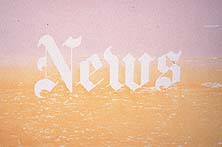 Over
50 prints are showcased in this premiere presentation of images from Ed
Ruscha's complete graphic archive. This superb body of work by Ruscha (pronounced
Rew-Shay), was recently acquired by the Fine Arts Museums for its collection
of contemporary art in the Achenbach Foundation for Graphic Arts. (left:
News, 1970, color screenprint, printed with black currant pie filling
and red salmon roe, 23 x 31 inches, Fine Arts Museums, Phyllis Wattis Purchase
Fund, 2000)
Over
50 prints are showcased in this premiere presentation of images from Ed
Ruscha's complete graphic archive. This superb body of work by Ruscha (pronounced
Rew-Shay), was recently acquired by the Fine Arts Museums for its collection
of contemporary art in the Achenbach Foundation for Graphic Arts. (left:
News, 1970, color screenprint, printed with black currant pie filling
and red salmon roe, 23 x 31 inches, Fine Arts Museums, Phyllis Wattis Purchase
Fund, 2000)
The archive, which numbers 1100 graphic images, both builds on and complements the museum's important holdings in the Anderson Graphic Arts Collection and the archives of Crown Point Press. Says Harry S. Parker III, Director of Museums, "The acquisition of the Ed Ruscha archive significantly deepens our holdings of late 20th-century art. It makes the Achenbach Foundation a major center for the display and study of American contemporary prints, and a destination for artists, scholars, and art collectors."
Ruscha (see biography below), whose work is already represented by a number of prints in the Achenbach's holdings, says, "I am tremendously pleased that my complete graphic works are housed in San Francisco. I think it is the most beautiful city in world, and it is a humbling experience to have my archive there, especially at a print center of the caliber of the Achenbach Foundation for Graphic Arts."
Acquisition of the archive of Ed Ruscha was made with funds from the Phyllis Wattis Purchase Fund, a gift of $10 million from San Francisco philanthropist Phyllis Wattis specifically for the purchase of major, historically critical works of art in preparation for a new de Young Museum in Golden Gate Park.
A Uniquely American Sensibility
For more than 35 years, Ed Ruscha has been not only an influential voice in post-war American painting, but also one of contemporary art's most significant graphic artists. From his first prints and artist's books made in the early 1960s to his latest projects, Ruscha has created a body of editioned work that is uniquely American in subject and sensibility. Ruscha's consistently inventive prints blend Pop, Surrealist, and Conceptual ideas with his own signature deadpan sense of humor.
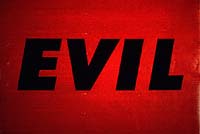 Born in Omaha, Nebraska, in 1937
and raised in Oklahoma City, Ruscha moved to Los Angeles in 1956 to study
commercial art. The fundamentals of layout, lettering, and illustration
that he learned soon became an significant influence on his work. Equally
important in the formation of his oeuvre was his ability to see Los Angeles
through the eyes of an outsider and to document in his work the ethos of
the modern, sprawling metropolis with a vernacular all its own. The result
is a highly distinctive and individual art that, to many, epitomizes aspects
of a Los Angeles sensibility that thrives on popular culture, illusionism,
humor, and a romantic sense of nostalgia. (right: Evil, 1973,
screenprint, 19 7/8 x 29 11/16 inches, Fine Arts Museums, Phyllis Wattis
Purchase Fund, 2000)
Born in Omaha, Nebraska, in 1937
and raised in Oklahoma City, Ruscha moved to Los Angeles in 1956 to study
commercial art. The fundamentals of layout, lettering, and illustration
that he learned soon became an significant influence on his work. Equally
important in the formation of his oeuvre was his ability to see Los Angeles
through the eyes of an outsider and to document in his work the ethos of
the modern, sprawling metropolis with a vernacular all its own. The result
is a highly distinctive and individual art that, to many, epitomizes aspects
of a Los Angeles sensibility that thrives on popular culture, illusionism,
humor, and a romantic sense of nostalgia. (right: Evil, 1973,
screenprint, 19 7/8 x 29 11/16 inches, Fine Arts Museums, Phyllis Wattis
Purchase Fund, 2000)
Through the purchase of the Ed Ruscha archive, the Fine Arts Museums acquires one of every published edition of Ruscha prints, which number over 325 impressions; approximately 800 working proofs, color proofs, trial proofs, and cancellation proofs; and an impression of every future Ed Ruscha editioned print, photograph, or other published project. "I am very much looking forward to the collaborative aspect of this arrangement," says Ruscha. "It's a great honor to have an ongoing relationship with the Fine Arts Museums." The acquisition of the archive was facilitated by the active and generous participation of the artist and by the Anthony d'Offay Gallery of London, which represents Mr. Ruscha.
Says Robert Flynn Johnson, Curator in Charge of the Achenbach Foundation for Graphic Arts, "There is no single group of American prints available, currently, or conceivably in the future, that would be a greater acquisition for the Fine Arts Museums than the archive of Ed Ruscha. The fact that Ruscha is a California artist as well as an artist of international stature further enhances the acquisition."
Work from Three Decades on View in Exhibition at Legion
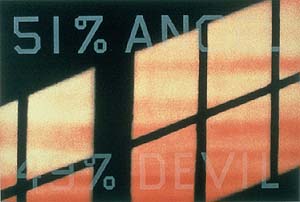 Acquisition of an Archive: The
Graphic Works of Ed Ruscha, provides the occasion
for the first presentation to Bay Area audiences of works from the newly-acquired
archive. The exhibition will highlight works from approximately three decades
of printmaking, including early prints that feature emblems of popular culture
such as the Standard gasoline station, in Standard Station (1966).
Well-known prints made in the 1970s and 1980s depict words as both subject
and object: Evil and Excuse Me are some that will be exhibited.
Also on view will be recent prints made at Crown Point Press and the Mixografia
Workshop that probe archetypal imagery such as the weathervane, the hourglass,
and the hunting dog. (left: 51% Angel/49% Devil, 1984, lithograph,
22 1/3 x 30 inches, Fine Arts Museums, Phyllis Wattis Purchase Fund, 2000)
Acquisition of an Archive: The
Graphic Works of Ed Ruscha, provides the occasion
for the first presentation to Bay Area audiences of works from the newly-acquired
archive. The exhibition will highlight works from approximately three decades
of printmaking, including early prints that feature emblems of popular culture
such as the Standard gasoline station, in Standard Station (1966).
Well-known prints made in the 1970s and 1980s depict words as both subject
and object: Evil and Excuse Me are some that will be exhibited.
Also on view will be recent prints made at Crown Point Press and the Mixografia
Workshop that probe archetypal imagery such as the weathervane, the hourglass,
and the hunting dog. (left: 51% Angel/49% Devil, 1984, lithograph,
22 1/3 x 30 inches, Fine Arts Museums, Phyllis Wattis Purchase Fund, 2000)
Karin Breuer, Curator of Prints, and curator of the exhibition notes, "Since its beginnings in 1948, a major focus of the Achenbach Foundation for Graphic Arts has been collecting contemporary art, particularly that of California and Bay Area artists. With the inclusion of the graphic archive of Southern California's most prominent artist, Ed Ruscha, who has made prints at the most important and active southern California presses, we now have unparalleled strength in the area of California printmaking."
Edward Ruscha Biography
As a child growing up in Oklahoma City, Ed Ruscha drew comics of everyday life and took painting lessons from a portraitist. In the early sixties, he worked for an advertising agency, after which he made his first paintings using words, which became a prime focus for him in both his paintings and his graphic work. His first words were rendered in great brushstrokes of Abstract Expressionist paint, which later became words that floated against a variety of backgrounds, from pastel to Pepto Bismol. The words "Artesia," "Hollywood," "Highland," and "Sunset," played off Los Angeles street names and brought the metaphorical symbolism of the words into context. Such phrases as "Those Golden Spasms" and "I Remembered to Forget to Remember" became paintings and underscored his art.
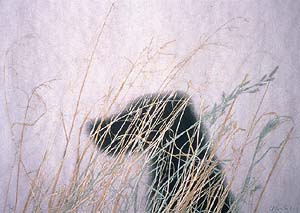 Beginning in 1963, he also turned
to photography, and Ed Ruscha's artist's books are among the most influential
works of art of the late 1960s and early 1970s, documenting typologies such
as the buildings along the Sunset Strip, Los Angeles apartment buildings,
and gas stations. The photographs ask the viewer to consider the vernacular-built
environment as an index of contemporary society. During this period he also
made two films, Premium and Miracle, produced in 1970 and
1975, respectively. (left: Dog, 1995, mixed media, 27 1/4
x 38 1/2 inches, Fine Arts Museums, Anderson Graphic Arts Collection, 2000)
Beginning in 1963, he also turned
to photography, and Ed Ruscha's artist's books are among the most influential
works of art of the late 1960s and early 1970s, documenting typologies such
as the buildings along the Sunset Strip, Los Angeles apartment buildings,
and gas stations. The photographs ask the viewer to consider the vernacular-built
environment as an index of contemporary society. During this period he also
made two films, Premium and Miracle, produced in 1970 and
1975, respectively. (left: Dog, 1995, mixed media, 27 1/4
x 38 1/2 inches, Fine Arts Museums, Anderson Graphic Arts Collection, 2000)
Considered both a pop and conceptual artist, Ruscha's work
has been widely exhibited in numerous major shows in cities in the United
States and around the world, including Paris, Rotterdam, Barcelona, and
Tokyo. The first retrospective of his work, I Don't Want No Retrospective
-- the Works of Edward Ruscha, was in 1982 at the San Francisco Museum
of Modem Art. Currently, he has two retrospectives traveling in the United
States and Europe: Edward Ruscha, organized by the Hirshhorn Museum
& Sculpture Garden, and Edward Ruscha: Editions:1959-1999; organized
by the Walker Art Center. In addition, he is represented in a lengthy list
of national permanent collections that includes the Museum of Modern Art
and the Whitney Museum in New York, the Los 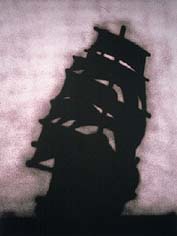 Angeles
County Museum of Art, the Hirshhorn Museum & Sculpture Garden in Washington,
D.C., and the Fine Arts Museums of San Francisco, as well as many prestigious
international collections.
Angeles
County Museum of Art, the Hirshhorn Museum & Sculpture Garden in Washington,
D.C., and the Fine Arts Museums of San Francisco, as well as many prestigious
international collections.
In 1997 Ruscha completed his most recent public commission, a 23-foot-tall mural entitled "Picture Without Words," for the J. Paul Getty Museum complex in Los Angeles. The mural is installed in the lobby of the Getty Center's Harold Williams Auditorium. Other public commissions include a circular mural commissioned for the Miami-Dade Public Library in 1985 by the Metro-Dade Art in Public Places Trust, which also commissioned 35 lunette paintings for the library in 1989. In 1994, the Mayor's Office of Art, Culture, and Film, the City and County of Denver, commissioned paintings for the Great Hall of the Denver Central Library. (right: Ship, 1986, lithograph, 45 x 34 inches, Fine Arts Museums, Phyllis Wattis Purchase Fund, 2000)
In 2000, Ruscha's complete graphic archive of over 1100 works was acquired by the Fine Arts Museums of San Francisco for its graphic art collection, which is housed in the Achenbach Foundation for Graphic Arts. The exhibition Acquisition of an Archive: The Graphic Works of Ed Ruscha, on view from May 12--October 7, 2001, at the California Palace of the Legion of Honor is the premiere showing in San Francisco of prints from the archive.
Read more about the Fine Arts Museums of San Francisco in Resource Library Magazine
Please click on thumbnail images bordered by a red line to see enlargements.
This page was originally published in Resource Library Magazine. Please see Resource Library's Overview section for more information. rev. 6/7/11
Search Resource Library for thousands of articles and essays on American art.
Copyright 2011 Traditional Fine Arts Organization, Inc., an Arizona nonprofit corporation. All rights reserved.